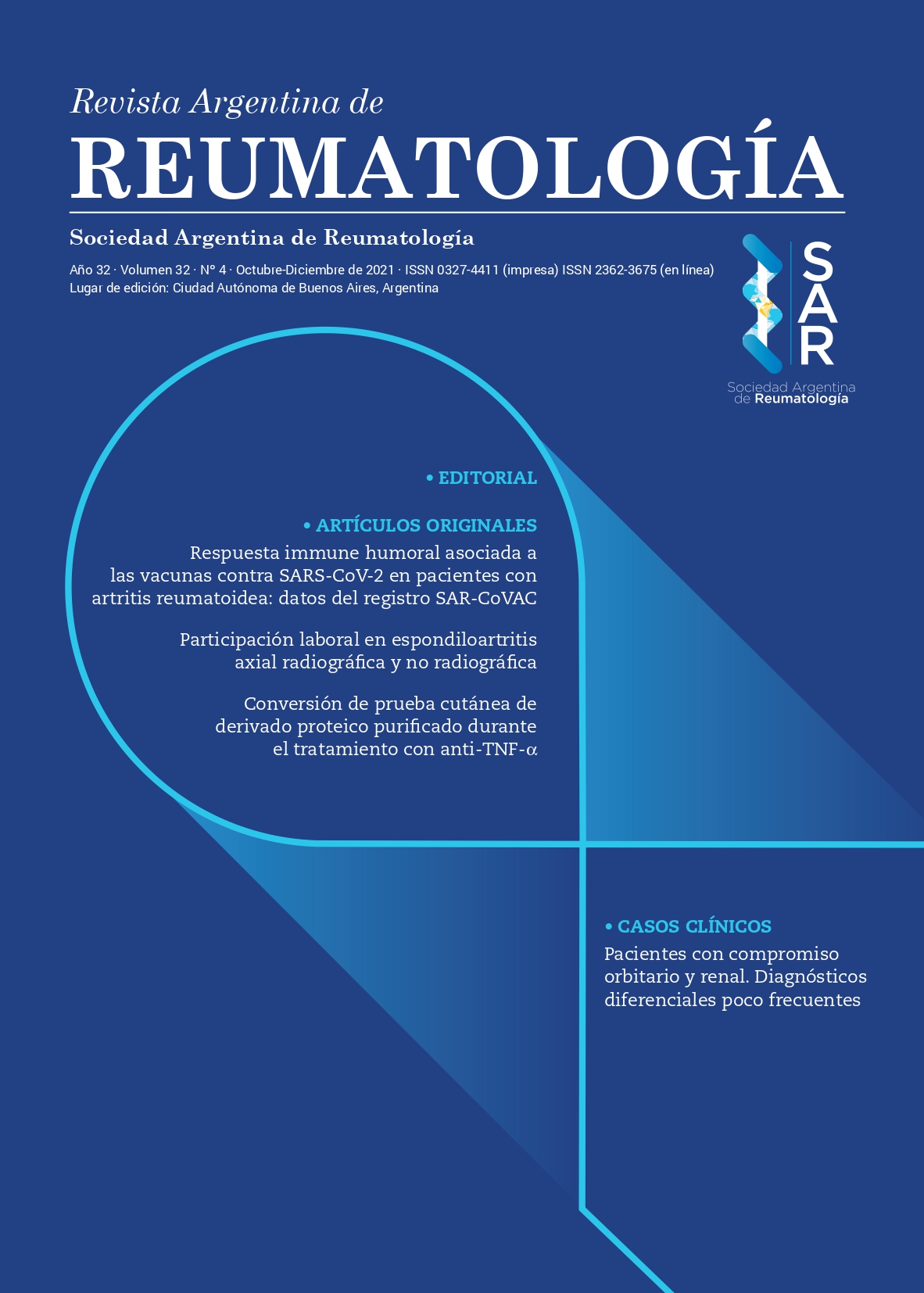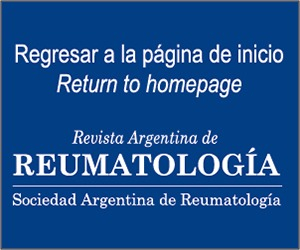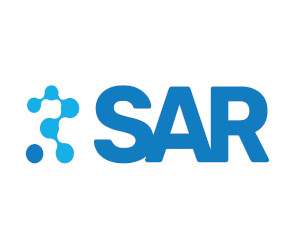Certolizumab para el tratamiento de un paciente con artritis reumatoidea refractaria a múltiples agentes biológicos
Resumen
Hoy en día contamos con un amplio abanico de tratamientos posibles para la artritis reumatoidea, empezando por el metotrexato como droga de primera línea, además de diversas drogas modificadores de la artritis reumatoidea (DMAR) y agentes biológicos. Sin embargo, una problemática se plantea en aquellos pacientes que son no respondedores a los diversos agentes, en quienes las guías de tratamiento internacionales ya no plantean opciones. Se presenta el caso clínico de una paciente con AR con falla a múltiples DMAR y agentes biológicos de diferentes mecanismos de acción y que finalmente responde a un nuevo inhibidor de los anti-TNF (Certolizumab pegol). Se discuten las posibilidades terapéuticas en estos pacientes y los datos relacionados con el Certolizumab pegol.Citas
I. Arnett F, Edworthy S, Bloch D, McShane D, Fries J, Cooper N, et al. The American Rheumatism Asso-ciation 1987 revised criteria for the classification of rheumatoid arthritis. Arthritis Rheum 1988; 31:315-24.
II. Federico Navarro-Sarabia, Dolores Ruiz-Montesi-nos, Blanca Hernandez, Victoria Navarro-Compán, Sara Marsal, Mireia Barcelo, Eva Perez-Pampín and Juan J Gómez-Reino. DAS-28-based EULAR response and HAQ improvement in rheumatoid arthritis patients switching between TNF antago-nists. BMC Musculoskeletal Disorders 2009, 10:91 doi:10.1186/1471-2474-10-91.
III. Remy A, Avouac J, Combe B. Clinical relevance of switching to a second tumor necrosis factor-alpha in-hibitor after discontinuation of a first tumor necrosis factor-alpha inhibitor in rheumatoid arthritis: A sys-tematic literature review and meta-analysis. Clin Exp Rheumatol 2011; 29:96-103.
IV. Nesbitt A, Fossati G, Bergin M, Stephens P, Stephens S, Foulkes R, et al. Mechanism of action of certolizu-mab pegol (CDP870): In vitro comparison with other anti-tumor necrosis factor alpha agents. Inflamm Bowel Dis 2007; 13:1323-32.
V. Ware JE, Snow KK, Kosinski M, Gandek B. SF-36 health survey manual and interpretation guide. Bos-ton, Massachusetts, USA: New England Medical Center/The Health Institute, 1993.
VI. Kirwan JR, Reeback JS. Stanford Health Assessment Questionnaire modified to assess disability in British patients with rheumatoid arthritis. Br J Rheumatol 1986; 25:206-9.
VII. Ware JE, Kosinski M, Keller SK. SF-36 physical and mental health summary scales: a user’s manual. Bos-ton, Massachusetts, USA: New England Medical Center/The Health Institute, 1994.
VIII. Hewlett S, Hehir M, Kirwan JR. Measuring fatigue in rheumatoid arthritis: a systematic review of scales in use. Arthritis Rheum 2007; 57:429-39.
IX. Edward Keystone, Désirée van der Heijde, David Mason, Jr., Robert Landewé, Ronald van Vollenhoven, Bernard Combe, Paul Emery, Vibeke Strand, Philip Mease, Chintu Desai, and Karel Pavelka. Cer-tolizumab Pegol Plus Methotrexate Is Significantly More Effective Than Placebo Plus Methotrexate in Active Rheumatoid Arthritis Findings of a Fifty-Two–Week, Phase III, Multicenter, Randomized, Double-Blind, Placebo-Controlled, Parallel-Group Study. Arthritis & Rheumatism November 2008; 58(11):3319-3329.
X. J Smolen, R B Landewé, P Mease, J Brzezicki, D Ma-son, K Luijtens, R F van Vollenhoven, A Kavanaugh, M Schiff, G R Burmester, V Strand, J Vencovsky, D van der Heijde. Efficacy and safety of certolizumab pegol plus methotrexate in active rheumatoid arthri-tis: the RAPID 2 study. A randomised controlled trial. Ann Rheum Dis 2009; 68:797-804.
XI. Michael E. Weinblatt, Roy Fleischmann, Tom W. J. Huizinga, Paul Emery, Janet Pope, Elena M. Massarotti, Ronald F. van Vollenhoven, Jürgen Wo-llenhaupt, Clifton O. Bingham III, Ben Duncan, Niti Goel, Owen R. Davies and Maxime Dougados. Efficacy and safety of certolizumab pegol in a broad population of patients with active rheumatoid arthri-tis: results from the REALISTIC phase IIIb study. Rheumatology (Oxford. 2012 Dec; 51(12):2204-14.
XII. R Fleischmann, J Vencovsky, R F van Vollenho-ven, D Borenstein, J Box, G Coteur, N Goel,7 H-P Brezinschek, A Innes, V Strand. Efficacy and safety of certolizumab pegol monotherapy every 4 weeks in patients with rheumatoid arthritis failing previous disease modifying antirheumatic therapy: the FAST-4WARD study. Ann Rheum Dis 2009; 68:805-811.
XIII. Edward C. Keystone, Bernard Combe, Josef Smolen, Vibeke Strand, Niti Goel, Ronald van Vollenhoven, Philip Mease, Robert Landewé, Roy Fleischmann, Kristel Luijtens and Désirée van der Heijde. Sustained efficacy of certolizumab pegol added to methotrexa-te in the treatment of rheumatoid arthritis: 2-year results from the RAPID 1 trial. Rheumatology (Oxford). 2012 Sep; 51(9):1628-38.
XIV. Sokka T, Pincus T. Most patients receiving routine care for rheumatoid arthritis in 2001 did not meet inclusion criteria for most recent clinical trials or American College of Rheumatology criteria for re-mission. J Rheumatol 2003; 30:1138-46.
XV. Zink A, Strangfeld A, Schneider M, et al. Effectiveness of tumor necrosis factor inhibitors in rheumatoid ar-thritis in an observational cohort study: comparison of patients according to their eligibility for major randomi-zed clinical trials. Arthritis Rheum 2006; 54:3399-407.
Derechos de autor 2014 Revista Argentina de Reumatología

Esta obra está bajo licencia internacional Creative Commons Reconocimiento-NoComercial-SinObrasDerivadas 4.0.






